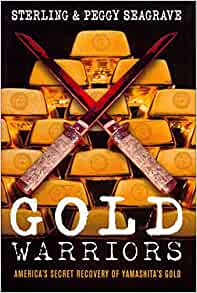Yamashita's gold
 | |
| Interest of | • David Guyatt • Peggy Seagrave |
| An alleged cache of war loot reportedly captured by the Japanese in Asia in WW2, possibly repossessed by the CIA and used to fund the development of the US Deep state. | |
Yamashita's gold, also referred to as the Yamashita treasure, is the name given to the alleged war loot stolen in Southeast Asia by Imperial Japanese forces during World War II and hidden in caves, tunnels, underground complexes, or just underground in the Philippines. It is named after the Japanese general Tomoyuki Yamashita, nicknamed "The Tiger of Malaya".
Exposure
Prominent among those who have argued for the existence of Yamashita's gold are Sterling Seagrave and his wife Peggy Seagrave, who wrote two books related to the subject: The Yamato Dynasty: The Secret History of Japan's Imperial Family (2000) and Gold Warriors: America's Secret Recovery of Yamashita's Gold (2003). The Seagraves contend that looting was organized on a massive scale, by both yakuza gangsters such as Yoshio Kodama, and the highest levels of Japanese society, including Emperor Hirohito. The looting included the sack of the Chinese capital Nanking in 1937, when Japan took 6,600 tons of gold[1].
Golden Lily
The Japanese government intended that loot from Southeast Asia would finance Japan's war effort. The Seagraves allege that Hirohito appointed his brother, Prince Yasuhito Chichibu, to head a secret organization named Kin no yuri ("Golden Lily"), for this purpose. The Seagraves and others[2] have claimed that American military intelligence operatives, including Edward Lansdale, located much of the loot; they colluded with Hirohito and other senior Japanese figures to conceal its existence, and they used it to finance American covert intelligence operations around the world during the Cold War.
CIA collection
On orders from Washington, Lansdale supervised the recovery of several Golden Lily vaults, inventoried the bullion, and had it trucked to warehouses at the US Naval base at Subic Bay or the Air Force base at Clark Field. According to the Seagraves, two members of Stimson’s staff, together with financial experts from the newly formed CIA deposited the gold in 176 reliable banks in 42 different countries. These deposits were made in his own name or in one of his numerous aliases in order to keep the identity of the true owners secret. Once the gold was in their vaults, the banks would issue certificates that are even more negotiable than money, being backed by gold itself. With this seemingly inexhaustible source of cash, the CIA set up slush funds to influence politics in Japan, Greece, Italy, Britain and many other places around the world. For example, money from what was called the ‘M-Fund’ (named after Major-General William Marquat of MacArthur’s staff) was secretly employed to pay for Japan’s initial rearmament after the outbreak of the Korean War, since the Japanese Diet itself refused to appropriate money for the purpose.[3]
Related Document
| Title | Type | Publication date | Author(s) | Description |
|---|---|---|---|---|
| Document:The Spoils of War | article | 2002 | David Guyatt | An introduction to the murky subject of the gold plundered by the NAZI and Japanese militaries during World War II and what happened to it. |